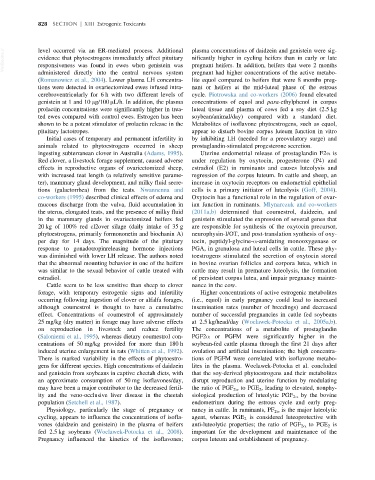Page 870 - Veterinary Toxicology, Basic and Clinical Principles, 3rd Edition
P. 870
828 SECTION | XIII Estrogenic Toxicants
VetBooks.ir level occurred via an ER-mediated process. Additional plasma concentrations of daidzein and genistein were sig-
nificantly higher in cycling heifers than in early or late
evidence that phytoestrogens immediately affect pituitary
pregnant heifers. In addition, heifers that were 2 months
responsiveness was found in ewes when genistein was
administered directly into the central nervous system pregnant had higher concentrations of the active metabo-
(Romanowicz et al., 2004). Lower plasma LH concentra- lite equol compared to heifers that were 8 months preg-
tions were detected in ovariectomized ewes infused intra- nant or heifers at the mid-luteal phase of the estrous
cerebroventricularly for 6 h with two different levels of cycle. Piotrowska and co-workers (2006) found elevated
genistein at 1 and 10 μg/100 μL/h. In addition, the plasma concentrations of equol and para-ethylphenol in corpus
prolactin concentrations were significantly higher in trea- luteal tissue and plasma of cows fed a soy diet (2.5 kg
ted ewes compared with control ewes. Estrogen has been soybean/animal/day) compared with a standard diet.
shown to be a potent stimulator of prolactin release in the Metabolites of isoflavone phytoestrogens, such as equol,
pituitary lactotropes. appear to disturb bovine corpus luteum function in vitro
Initial cases of temporary and permanent infertility in by inhibiting LH (needed for a preovulatory surge) and
animals related to phytoestrogens occurred in sheep prostaglandin-stimulated progesterone secretion.
ingesting subterranean clover in Australia (Adams, 1995). Uterine endometrial release of prostaglandin F2α is
Red clover, a livestock forage supplement, caused adverse under regulation by oxytocin, progesterone (P4) and
effects in reproductive organs of ovariectomized sheep, estradiol (E2) in ruminants and causes luteolysis and
with increased teat length (a relatively sensitive parame- regression of the corpus luteum. In cattle and sheep, an
ter), mammary gland development, and milky fluid secre- increase in oxytocin receptors on endometrial epithelial
tions (galactorrhea) from the teats. Nwannenna and cells is a primary initiator of luteolysis (Goff, 2004).
co-workers (1995) described clinical effects of edema and Oxytocin has a functional role in the regulation of ovar-
mucous discharge from the vulva, fluid accumulation in ian function in ruminants. Mlynarczuk and co-workers
the uterus, elongated teats, and the presence of milky fluid (2011a,b) determined that coumestrol, daidzein, and
in the mammary glands in ovariectomized heifers fed genistein stimulated the expression of several genes that
20 kg of 100% red cl2over silage (daily intake of 35 g are responsible for synthesis of the oxytocin precursor,
phytoestrogens, primarily formononetin and biochanin A) neurophysin-I/OT, and post-translation synthesis of oxy-
per day for 14 days. The magnitude of the pituitary tocin, peptidyl-glycine-α-amidating monooxygenase or
response to gonadotropinreleasing hormone injections PGA, in granulosa and luteal cells in cattle. These phy-
was diminished with lower LH release. The authors noted toestrogens stimulated the secretion of oxytocin stored
that the abnormal mounting behavior in one of the heifers in bovine ovarian follicles and corpora lutea, which in
was similar to the sexual behavior of cattle treated with cattle may result in premature luteolysis, the formation
estradiol. of persistent corpus lutea, and impair pregnancy mainte-
Cattle seem to be less sensitive than sheep to clover nance in the cow.
forage, with temporary estrogenic signs and infertility Higher concentrations of active estrogenic metabolites
occurring following ingestion of clover or alfalfa forages, (i.e., equol) in early pregnancy could lead to increased
although coumestrol is thought to have a cumulative insemination rates (number of breedings) and decreased
effect. Concentrations of coumestrol of approximately number of successful pregnancies in cattle fed soybeans
25 mg/kg (dry matter) in forage may have adverse effects at 2.5 kg/head/day (Woclawek-Potocka et al., 2005a,b).
on reproduction in livestock and reduce fertility The concentrations of a metabolite of prostaglandin
(Saloniemi et al., 1995), whereas dietary coumestrol con- PGF2α or PGFM were significantly higher in the
centrations of 50 mg/kg provided for more than 180 h soybean-fed cattle plasma through the first 21 days after
induced uterine enlargement in rats (Whitten et al., 1992). ovulation and artificial insemination; the high concentra-
There is marked variability in the effects of phytoestro- tions of PGFM were correlated with isoflavone metabo-
gens for different species. High concentrations of daidzein lites in the plasma. Woclawek-Potocka et al. concluded
and genistein from soybeans in captive cheetah diets, with that the soy-derived phytoestrogens and their metabolites
an approximate consumption of 50 mg isoflavones/day, disrupt reproduction and uterine function by modulating
may have been a major contributor to the decreased fertil- the ratio of PGF 2α to PGE 2 , leading to elevated, nonphy-
ity and the veno-occlusive liver disease in the cheetah siological production of luteolytic PGF 2α by the bovine
population (Setchell et al., 1987). endometrium during the estrous cycle and early preg-
Physiology, particularly the stage of pregnancy or nancy in cattle. In ruminants, PF 2α is the major luteolytic
cycling, appears to influence the concentrations of isofla- agent, whereas PGE 2 is considered luteoprotective with
vones (daidzein and genistein) in the plasma of heifers anti-luteolytic properties; the ratio of PGF 2α to PGE 2 is
fed 2.5 kg soybeans (Woclawek-Potocka et al., 2008). important for the development and maintenance of the
Pregnancy influenced the kinetics of the isoflavones; corpus luteum and establishment of pregnancy.

